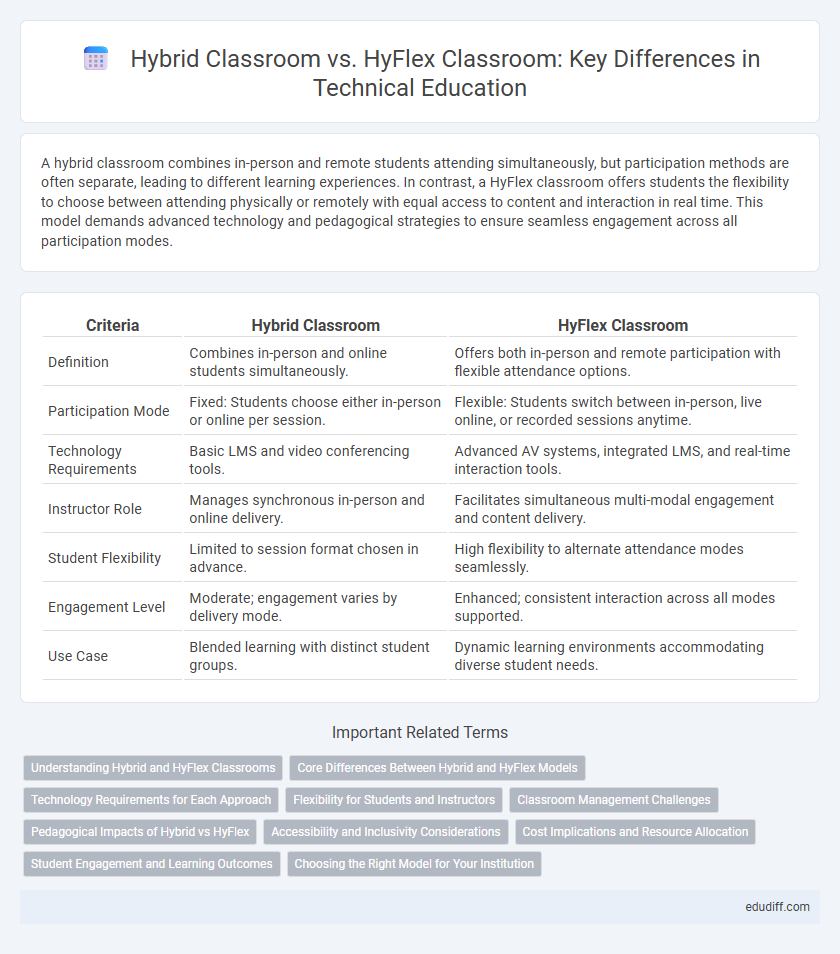A hybrid classroom combines in-person and remote students attending simultaneously, but participation methods are often separate, leading to different learning experiences. In contrast, a HyFlex classroom offers students the flexibility to choose between attending physically or remotely with equal access to content and interaction in real time. This model demands advanced technology and pedagogical strategies to ensure seamless engagement across all participation modes.
Table of Comparison
| Criteria | Hybrid Classroom | HyFlex Classroom |
|---|---|---|
| Definition | Combines in-person and online students simultaneously. | Offers both in-person and remote participation with flexible attendance options. |
| Participation Mode | Fixed: Students choose either in-person or online per session. | Flexible: Students switch between in-person, live online, or recorded sessions anytime. |
| Technology Requirements | Basic LMS and video conferencing tools. | Advanced AV systems, integrated LMS, and real-time interaction tools. |
| Instructor Role | Manages synchronous in-person and online delivery. | Facilitates simultaneous multi-modal engagement and content delivery. |
| Student Flexibility | Limited to session format chosen in advance. | High flexibility to alternate attendance modes seamlessly. |
| Engagement Level | Moderate; engagement varies by delivery mode. | Enhanced; consistent interaction across all modes supported. |
| Use Case | Blended learning with distinct student groups. | Dynamic learning environments accommodating diverse student needs. |
Understanding Hybrid and HyFlex Classrooms
Hybrid classrooms integrate in-person and online students simultaneously, allowing real-time interaction through video conferencing tools and shared digital resources. HyFlex classrooms offer flexible participation modes, enabling students to choose between attending face-to-face, joining live online sessions, or accessing recorded lectures asynchronously. Both models leverage technology to enhance accessibility and engagement but differ in the level of choice and adaptability provided to learners.
Core Differences Between Hybrid and HyFlex Models
Hybrid classrooms combine in-person and remote students who participate simultaneously in a fixed schedule with synchronous instruction. HyFlex classrooms provide maximum flexibility, allowing students to choose between attending face-to-face, joining online synchronously, or engaging asynchronously through recorded materials. The core difference lies in HyFlex's adaptive modality options, empowering personalized learning pathways versus Hybrid's predetermined dual-mode presence.
Technology Requirements for Each Approach
Hybrid classrooms require reliable video conferencing tools, high-quality cameras, and microphones to facilitate simultaneous in-person and remote student participation. HyFlex classrooms demand more advanced technology, including integrated learning management systems (LMS), multi-directional microphones, automated camera tracking, and robust Wi-Fi infrastructure to support seamless switching between face-to-face and online modes. Both approaches benefit from interactive digital platforms and real-time collaboration software to enhance engagement and accessibility.
Flexibility for Students and Instructors
Hybrid classrooms blend in-person and remote learning but schedule specific student groups separately, limiting flexibility for real-time participation. HyFlex classrooms offer simultaneous in-person and online sessions, allowing students and instructors to seamlessly choose and switch between attendance modes based on their schedules. This model maximizes adaptability, supports diverse learning preferences, and enhances engagement through dynamic, hybrid instructional delivery.
Classroom Management Challenges
Hybrid classrooms present classroom management challenges such as coordinating synchronous and asynchronous participation while maintaining student engagement. HyFlex classrooms complicate management further by requiring seamless technology integration to support students attending both in-person and online simultaneously. Effective management in HyFlex settings demands robust platform interoperability and real-time monitoring to address diverse learner needs and minimize disruptions.
Pedagogical Impacts of Hybrid vs HyFlex
Hybrid classrooms primarily separate in-person and remote students, often leading to distinct learning experiences and potential disparities in engagement and interaction quality. HyFlex classrooms offer flexible participation modes, allowing students to choose attendance methods daily, promoting inclusivity and personalized learning while requiring robust technological integration and adaptive teaching strategies. The pedagogical impact of HyFlex models enhances learner autonomy and equity but demands significant faculty training to maintain consistent instructional quality across modalities.
Accessibility and Inclusivity Considerations
Hybrid classrooms provide separate in-person and remote learning experiences, which may create barriers for students with disabilities due to inconsistent access to accommodations. HyFlex classrooms leverage flexible technology allowing all students to participate simultaneously, enhancing accessibility through real-time captioning, adaptive tools, and customizable learning modes. Inclusive design in HyFlex environments supports diverse learning needs, fostering equity by ensuring all students have equal access to course content regardless of location or ability.
Cost Implications and Resource Allocation
Hybrid classrooms often require less initial infrastructure investment compared to HyFlex classrooms, which demand advanced technology to support simultaneous in-person and remote participation. Cost implications for HyFlex models include higher expenses for robust audiovisual equipment, software licenses, and ongoing technical support to ensure seamless integration. Resource allocation in HyFlex settings typically involves dedicated staff for real-time monitoring and troubleshooting, whereas hybrid classrooms may allocate resources more flexibly between face-to-face and remote components.
Student Engagement and Learning Outcomes
Hybrid classrooms combine in-person and remote students with a fixed schedule, often leading to divided attention and varied engagement levels, while HyFlex classrooms allow students to choose their mode of attendance, which increases flexibility and can enhance motivation and participation. Research indicates that HyFlex models improve learning outcomes by accommodating diverse learning preferences and fostering higher interactivity through synchronous and asynchronous activities. Data from multiple studies suggest that student engagement in HyFlex environments is significantly higher, correlating with improved academic performance and satisfaction.
Choosing the Right Model for Your Institution
Evaluating hybrid classroom versus HyFlex classroom models requires assessing institutional goals, technological infrastructure, and student needs to determine the most effective approach. Hybrid classrooms combine in-person and remote students with a fixed schedule, while HyFlex classrooms offer full flexibility, allowing students to choose their mode of participation daily. Selecting the right model hinges on balancing resource availability, instructional design complexity, and desired student engagement outcomes.
Hybrid Classroom vs HyFlex Classroom Infographic

 edudiff.com
edudiff.com